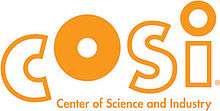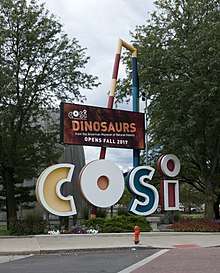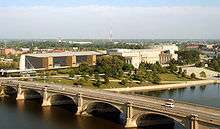COSI Columbus
 | |
| Independent, not-for-profit 501(c)(3) organization | |
| Industry | Education |
| Founded | 1964 in Columbus, Ohio |
| Founder | Sanford N. (Sandy) Hallock II |
| Headquarters | Columbus, Ohio |
Key people |
Dr. Frederic Bertley, President and CEO Pablo Vegas, Chair COSI Board of Trustees |
Number of employees | 200 (approx.) |
| Website | https://www.cosi.org |
COSI (an acronym for Center of Science and Industry) is a science museum and research center located in Columbus, Ohio in the United States. Originally opened in 1964, COSI was relocated to a 320,000 square foot state-of-the-art facility designed by Japanese architect Arata Isozaki along a bend in the Scioto River in the Franklinton neighborhood in 1999. COSI features more than 300 interactive exhibits throughout themed exhibition areas.[1]
As a “center of science and industry” (rather than a standalone “science center”),[2] COSI established embedded partnerships with local organizations. WOSU@COSI (Central Ohio’s NPR member station and Public Broadcasting Service public media station) maintains a digital media center and offices; OSU maintains a center of research as well as health & medicine laboratories staffed by medical residents; and Columbus Historical Society maintains offices and exhibit space.
COSI also operates the largest outreach education program of any science museum in the United States through COSI in the Classroom, 21st Century Lab field trip experiences, international distance education Interactive Video Conferencing programs, and COSI On Wheels traveling outreach program.[3] As well, COSI originated the Camp-In overnight program for Girl Scouts and Boy Scouts in 1972 – a concept that is now commonplace in museums nationwide. Since 1964, COSI has engaged with nearly 30 million unique visitors through on-site and outreach programs.[1]
As a not-for-profit organization, COSI is supported by ticket sales, a network of community and statewide partnerships (including relationships with a variety of donors and sponsors), a volunteer program supported by 10,000 volunteers annually, and nearly 20,000 member households.[4] In 2008, COSI was the named the #1 science center in the United States for families by Parent Magazine.[5]
Mission statement
As adopted in 1964... "COSI provides an exciting and informative atmosphere for those of all ages to discover more about our environment, our accomplishments, our heritage, and ourselves. We motivate a desire toward a better understanding of science, industry, health, and history through involvement in exhibits, demonstrations, and a variety of educational activities and experiences. COSI is for the enrichment of the individual and for a more rewarding life on our planet, Earth."[6]
Exhibit areas
Upon relocating to its new home in 1999, COSI was developed with large, self-contained, themed atria, each dedicated to a single topic (similar to the style of world’s fair pavilions) and designed as immersive theatrical “learning worlds.” As of 2018, COSI contains seven main exhibit areas: Ocean, Energy Explorers, Space, Progress, Gadgets, Life, and the American Museum of National History Dinosaur Gallery.[7] Hallways between each learning world are filled with hands-on exhibits and displays.
Ocean
The Ocean exhibit is divided into two realms. Accessed via an “underwater cave” through a crashed shipwreck, the cavern path splits as guests pass to the right or left. The pathway to the right leads to a docked submarine laboratory where hands-on exhibits explore the realities of ocean research, submersibles, SCUBA, water pressure, and remote-operated vehicles. Lilypad Lab focuses on drainage basin and Central Ohio wildlife. The path forking leftt from the shipwreck leads to the Temple of Poseidon, an “ancient” stone chamber built around a 30-foot tall statue of Poseidon with waterfalls, fountains, and water jets. This second realm focuses not on the study of water, but on the properties of water and the stories it inspires – laminar flow, whirlpools, erosion, water bells, and mythology.
Energy Explorers
Energy Explorers, which opened in 2013, allows visitors to choose an avatar (computing) character that follows the guest to the Home Zone, Transportation Zone, and Product Zone of a town, making decisions via computer kiosks to balance energy efficiency and cost.
Space
The Space exhibit area features a replica space station pod to tour, a recreation of John Glenn's Friendship 7 spacecraft from the Mercury-Atlas 6, remote-operated vehicles, balance tests, and other hands-on experiments that deal with space flight trajectory, gravitational pull, and simulated rover landings. Space was originally located on Level 2 in its own enclosed atrium exhibit area, entered via a "black hole" spinning funhouse hallway meant to disorient guests. The exhibit itself - like Ocean or Adventure - was in a dark, immersive, themed area, stylized after the 1969 moon landing of Apollo 11. Under starry skies, guests interacted with "retro" stylized monitors and exhibits with a matching wood-panel / brushed metal motif that was reminiscent of the era and united in style. The exhibit even included a 1960s living room (including shag carpeting) where guests could watch the recorded landing.
When the south end of COSI's building was closed due to lost levies in 2004, the Space exhibit was cut off. As such, it was relocated from Level 2 to an empty gallery on Level 1. In 2012, that area underwent construction to become Energy Explorers, necessitating yet another location switch. Some of the Space exhibit's displays moved to the Mezzanine Level while much remained in storage. With the re-opening of COSI's Planetarium in November 2014, the location of Space on the Mezzanine leading toward the Planetarium's lobby was reinforced by the return and refurbishment of the rest of Space's exhibits. However, Space still remains the only one of COSI's seven learning worlds to not have its own dedicated, theatrical, immersive atrium, instead being located on the bright Mezzanine bridge, open to the Atrium and entryway. The original home of Space is now Gallery 3, available for traveling exhibits and special event rentals. Gallery 3 still contains the Galaxy Theater, fittingly still painted with murals of planets and stars left over from its time as a live theater for Space.
Progress
The Progress exhibit (modeled after the “Streets of Yesteryear” exhibit at COSI’s original location) traces the hopes and fears of a small town called Progress in 1898, just as electricity, horseless carriages, and canned food become available. The recreated town (specifically, the shops, homes, and restaurants at the corner of Hope Street and Fear Street) includes a telegraph office, livery, stable, grocer, apothecary, and clothiers. After visitors walk through Progress in 1898, they turn the corner enter the same intersection of the same town 64 years later in 1962, where a new set of hopes and fears have arisen.
In 1962, the town of Progress includes an appliance store, working TV studio, radio station (where the telegraph office was), department store, diner, and gas station (replacing the livery). At the exit, the exhibit challenges guests to consider how the streets of the village of Progress might look today, and to question why the concept of progress deserves as much weight in scientific study as that of oceans, space, or energy.
Gadgets
The Gadgets exhibit area contains many classic science museum hands-on experiments, such as pulleys, wind tunnels, plasmaglobes, magnets, light bulbs, engines, and counterweights. As well, Gadgets contains the ‘Gadgets Café’, where families are seated and given a “menu” with quick science experiments to choose from. A “take-apart” menu allows visitors to disassemble donated phones, computers, clocks, and other electronic devices, which are recycled afterward.
Life
Life explores humanity through three separate areas dedicated to mind, body, and spirit. The Mind area contains optical illusions, physical illusions, an anechoic chamber, and a posable zoetrope. Spirit discusses the concept of birth and death and how human cultures understand them. Body features interactive health stations where visitors can record their weight, flexibility, and heart rate, then compare their statistics to that of COSI visitors and national averages. Life also contains the Labs in Life, three working medical research pods staffed by OSU Health & Medicine students and staff.

Dinosaur Gallery
On November 19 of 2017, COSI, in partnership with the American Museum of Natural History, opened a permanent Dinosaur Gallery. In addition, a traveling special exhibition gallery opened in Spring of 2018. Together, they will occupy 22,000 square feet on the first floor.[8]
Other features
The building also contains an interactive “little kidspace” area designed for children up through first grade, the National Geographic Giant Screen Theater (the largest digital screen in Ohio), and an outdoor Big Science Park. On November 22, 2014, COSI reopened its 60-foot diameter, 220-seat Planetarium (Ohio’s largest) with all new digital projection. In addition, there is a History of COSI exhibit.
The building also includes three large Galleries for traveling exhibits and special event hosting, a Dive Theater in Ocean, the Galaxy Theater in Gallery 3 (its name a remnant of when Gallery 3 was once the Space exhibit), the Gadgets Stage, the Atomic Cafe, the Science2Go! retail store, and five meeting rooms utilizing refurbished areas within the former Central High School, which the new COSI location was built around.
History

COSI opened on March 29, 1964, as a venture of the Franklin County Historical Society. COSI is a founding member of the Science Museum Exhibit Collaborative (SMEC) and a long-standing member of the Association of Science-Technology Centers (ASTC).
From its 1964 opening, COSI was housed in Memorial Hall, a Columbus landmark constructed in 1906. COSI closed at the Memorial Hall location on East Broad Street on September 6, 1999, and re-opened two months later on November 6, 1999, at its new location on the Scioto riverfront in downtown Columbus. The new, 320,000 square foot facility is one of the largest modern-built science centers in the world. The building was designed by internationally renowned Japanese architect Arata Isozaki, who designed an elliptical, geometric, "blimp" shaped structure composed of 159 curved concrete panels.[9] COSI is designed to appear progressively futuristic from the neighborhood of Franklinton, while from downtown Columbus it uses the exterior of the original Central High School to blend into the city.[9]
Shortly after the move to the riverfront, the museum experienced a shortfall of funds. With an initial construction budget of over $210 million, high maintenance costs of the new facility, "six figure" utility bills, and "lower-than-expected" ticket sales, COSI's reliance on admission revenue proved to be an unsuitable long term plan.[10] In 2004, the museum spearheaded an effort to assess a property tax levy, chaired by former NASA astronaut John Glenn. The levy would have imposed a property tax on residents of Franklin County, who would receive free admission in return. The levy failed. As a result, the south wing of COSI's "blimp" structure was closed.
As part of the reconfiguration of the museum following the loss of the levy in 2004, COSI opened only five days per week instead of seven. Many of the museum's exhibits were announced to close permanently (though many have re-opened in stages in the years since).[11] Two of the original exhibit areas were closed permanently (called i|o and SimZone, the spaces they formerly occupied are now Gallery 1 and Energy Explorers, respectively).
Closures from 2004 that have since been reversed include Space (relocated to Level 1 in 2005, then to the Mezzanine in 2012), the original Gallery 1 (space reused as WOSU@COSI in September 2006[12]), Adventure (re-opened as an additional-charge experience in September 2010[13]), CityView (still off limits to the public; now available for special events), and the Planetarium (re-opened in November 2014 as the final piece of the building to come back online[14]).

During the spring and summer of 2005, COSI hosted the blockbuster traveling exhibition "Titanic: The Artifact Exhibition" and saw record attendance (prompting the return of the exhibit in 2010). In the summer 2006, COSI hosted another large exhibit: "Star Wars: Where Science Meets Imagination", produced by the Museum of Science, Boston.
In April 2006 Dr. David Chesebrough, former president and CEO of the Buffalo Museum of Science, became COSI's new president and CEO. He replaced former NASA astronaut Kathryn D. Sullivan, who transitioned to a new role as COSI science advisor on a volunteer basis while serving in her new role as the Director of Ohio State University's Battelle Center for Mathematics and Science Education Policy.
Since then, COSI has integrated additional-cost traveling exhibits as part of its funding model. The museum has hosted EINSTEIN, An Exhibition on the Man and his Science (2007), Animation featuring Cartoon Network (2007), Gregor Mendel: Planting the Seeds of Genetics (2007), Bob the Builder: Project Build It (2007), Goosebumps! The Science of Fear (2008), CSI: The Experience (2008), Adventures with Clifford the Big Red Dog (2010), Geckos: From Tail to Toepads (2011), Dinosaurs: Explore. Escape. Survive. (2011), Dora and Diego - Let's Explore! (2011), RACE: Are We So Different? (2012), WATER (2012), LEGO Castle Adventure (2012), BODYWORLDS and The Brain (2012), MindBender Mansion and Amazing Mazes (2013), MythBusters: The Explosive Exhibition (2013), Curious George: Let's Get Curious! (2013), and Sherlock: The Exhibition (2014). As well, COSI developed its own traveling exhibit, Lost Egypt: Ancient Secrets, Modern Science (2009) in cooperation with the Science Museum Exhibit Collaborative, built by the Science Museum of Minnesota. Lost Egypt now travels the nation to other museums.
In January 2016, Dr. Chesebrough announced that he planned to retire at the end of 2016. A executive search firm was contracted, and an advisory committee formed, to identify candidates to succeed him as president and CEO.[15]
On August 23, 2016, the Capitol South Community Redevelopment Corp. announced the approval of a $37 million plan to replace the 600-spot parking lots on COSI's west side with an underground parking garage topped with an 8-acre green space and programmatic park as a compliment to the larger Scioto Peninsula green space along the Scioto River. The construction project is expected to be completed in spring 2018.[16]
On September 16, 2016, COSI announced a partnership between the city of Columbus and the American Museum of Natural History (AMNH) in New York City to build a $5 million permanent Dinosaur Exhibition Gallery and a dedicated AMNH Traveling Exhibition Gallery replacing the WOSU and Adventure exhibits. The WOSU exhibit has since relocated; however, the Adventure exhibition closed permanently on January 1, 2017.[17][18]
On November 10, 2016, the COSI board of trustees announced the selection of Dr. Frederic Bertley as COSI Columbus' new president and CEO, effective January 1, 2017. Dr. Bertley was previously senior vice president for science and education at the Franklin Institute in Philadelphia.[19]
On January 1, 2017, the Adventure exhibit permanently closed to make room for COSI's Dinosaur Gallery.[18]
Operating Statistics
| Year | Total Attendance Recorded | Cost of Admission |
|---|---|---|
| 1967 | 172,215 | |
| 1974 | 191,755 | |
| 1976 | 263,039 | |
| 1978 | $1.50 | |
| 1980 | 300,000 | |
| 1982 | 320,000 | |
| 1983 | $3.50 | |
| 1984 | 393,415 | |
| 1986 | 519,163 | |
| 1987 | 666,017 | |
| 1990 | 694,012 | |
| 1992 | 719,693 | |
| 1996 | $6.00 | |
| 1999 | $12.00 | |
| 2008 | 543,116 | |
| 2009 | 607,333 | |
| 2010 | 636,863 | |
| 2015 | 670,041 | $19.00 |
| 2016 | ||
| 2017 | $20.00 |
See also
- Imagination Station, formerly COSI Toledo, formerly affiliated with COSI Columbus.
References
- 1 2 "About COSI".
- ↑ "COSI's Center of Science Model" (PDF).
- ↑ "COSI - For Educators".
- ↑ "Volunteer & Employment".
- ↑ "Parents Magazine - 10 Best Science CentersI".
- ↑ "COSI - Mission Statement".
- ↑ "COSI - Exhibits & Live Shows".
- ↑ Gordon, Ken (September 16, 2016). "Columbus Dispatch". Retrieved December 11, 2017.
- 1 2 "High Concrete Group".
- ↑ "COSI Planetarium to go black; other programs scaled back".
- ↑ "COSI to reallocate exhibit spaces in September".
- ↑ "WOSU@COSI Grand Opening".
- ↑ "COSI to reopen popular Adventure exhibit".
- ↑ "COSI's renovated planetarium to reopen after decade absence".
- ↑ Shannon Gilchrist (January 29, 2016). "President who helped revive COSI announces he'll retire". Columbus Dispatch. Retrieved January 29, 2016.
- ↑ "COSI underground parking, park get go-ahead". August 23, 2016. Retrieved September 26, 2016.
- ↑ "$5 million from state budget to bring dinosaur exhibit to COSI]]". September 16, 2016. Retrieved September 26, 2016.
- 1 2 "COSI will close ‘Adventure’ exhibit to make room for natural history galleries]]". September 21, 2016. Retrieved September 26, 2016.
- ↑ http://www.dispatch.com/content/stories/local/2016/11/10/new-president-and-ceo-of-cosi.html
External links
- COSI official site
- COSI YouTube Channel
- COSI volunteer program
- A fansite/Virtual Trip through the Old COSI
Coordinates: 39°57′36″N 83°00′21″W / 39.959923°N 83.005794°W
